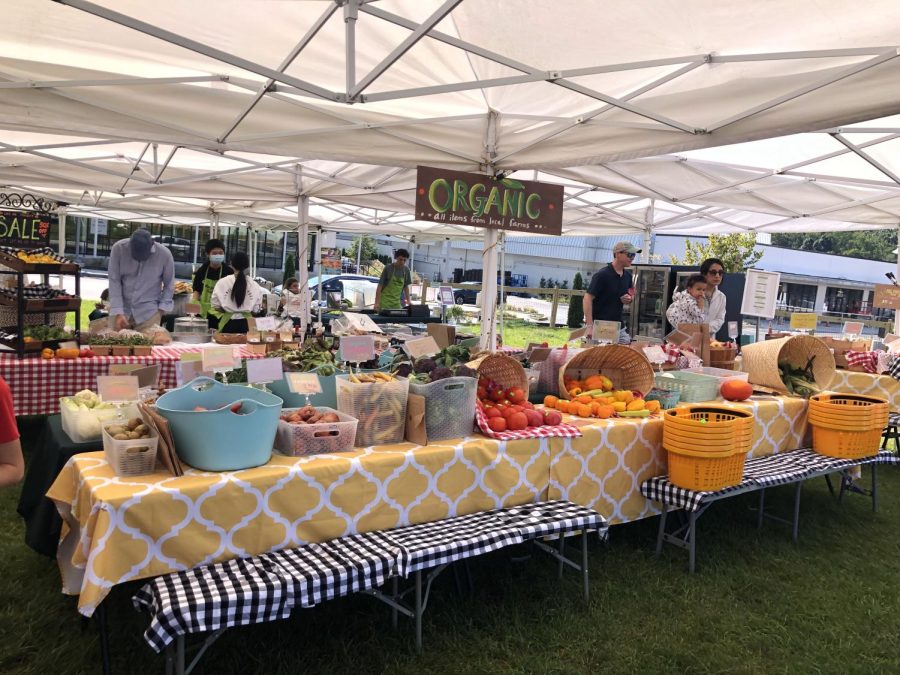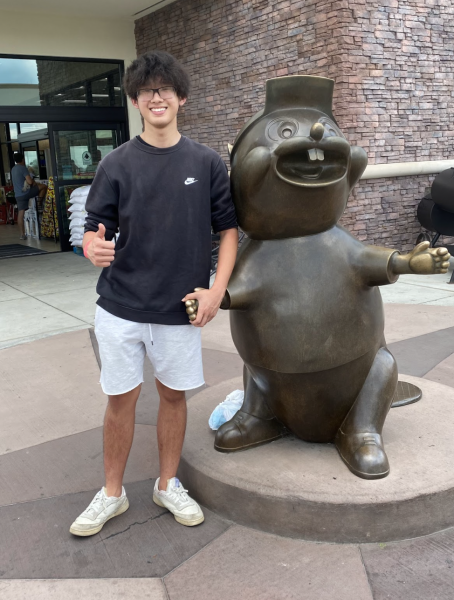Local market is a fresh pick for fruits and veggies
A stand in Milk Lady Markets in Cabin John Village offers a variety of organic produce from local farms, ranging from peppers to peaches.
October 20, 2022
Between the mini-mall and Capitol One Bank, bursts of laughter and wafts of fresh fruit and baked bread float through the chilly autumn air. Fall spirit is in full swing and with the festivities that the season typically brings—pumpkin patches, apple picking, haunted houses, coffeehouse studying—lies Milk Lady Markets (MLM), a hidden gem within Cabin John Village, open Sundays from 9:00 a.m. – 1:00 p.m. until October 30th.
“Our market is all about local food, fresh food and making it available to everyone,” Gigi Goin, the founder of MLM, said. “We host farmers from the area that are bringing their freshly produced crops and products and we are serving people here so we can have a successful market and affordable food.”
For Goin, food and farming are in her DNA. Born on a farm in the Trinidads, she was exposed to a variety of crops and the effects of diverse eating from a young age.
“I grew up on a farm as a kid, but my family moved away when I was 12, so I’m comfortable in a farm environment,” Goin said. “The thing is, I had a career in human resources for 20 to 22 years, and I was looking for what I wanted to do next. When I asked myself what I really loved, I realized that it’s healthy living and healthy eating. This eventually led me to the farmer’s market, and we’re now on our 12th season!”
An aspect of MLM that differentiates it from other farmers’ markets is Goin’s passion for tackling food insecurity in Maryland.
“Not everyone in our country is wealthy or even well-off, so we offer an initiative called ‘Double Dollars’ to create greater access to food,” Goin said. “For anybody who spends from government benefits like food stamps or Special Supplemental Nutrition Program for Women, Infants, and Children (WIC) vouchers, we give them tokens—each token is worth a dollar, so essentially, we double what they are spending.”
Specifically, in America, lack of access to quality food disproportionately impacts Black and Hispanic communities. According to data from the Maryland Food Bank, 52% of respondents who recently lost their jobs were BIPOC Marylanders—and 57% of that group had experienced struggles with affording food.
“Community supported agriculture (CSA) was started in the 60s during segregation in the South, when Black people couldn’t buy from white stores easily—it was either physically unsafe or emotionally unhealthy,” Goin said. “So, Booker T. Whatley said to the Black people in the area, ‘We should support the Black farms. Buy a share when the farmer needs money in the winter and when his crops are coming, everyone can come and start picking.’ They would come in and pick the food that they wanted for the week for their family.”
At MLM, Goin incorporates this same approach to ensure families in need have the ability to purchase high-standard food products at discounted prices.
“Our CSA is based on a market style because we want the customer to have a choice,” Goin said. “We bring everything directly from the farm to the vendor stands, and we say to our CSA members, ‘You buy at a certain subscription level according to your family size, you come in every week, and you spend down that balance.’”
As a result, Goin has built strong and personal relationships with the people that she works with and the people that shop at MLM.
“[The most rewarding part] is when a customer recognizes the quality that we offer when they tell us about something they tried and how good it is,” Goin said. “It means a lot because we source everything carefully: ensuring that milk is grass-fed, the yogurt is grass-fed, the ingredients, the quality, etc.”
For WCHS sophomore Sarah Bland, volunteering at MLM has offered her a chance to meet new people and give back to the community.
“I mainly help restock food, lay out products so that customers can look at it and answer any questions that they might have,” Bland said. “My favorite part is working with other volunteers—I’ve gotten to know them very well, and it hardly even feels like volunteering anymore. When you work with someone in close proximity every weekend, it’s hard not to feel some sort of community.”
Through volunteering, Bland has also gained a newfound appreciation for farmers.
“When it comes to farmers, I feel like they’re underappreciated in general,” Bland said. “They work a lot harder, and with food monopolies and corporations being in charge of the industry, it’s difficult for farmers to get a leg up. By establishing this farmers market, [Goin is] providing them an opportunity to sell their goods in an intimate and farmer-first process, which wouldn’t be the case if they were under a food giant monopoly.”
Through years of interactive involvement with the farming community, Goin has personally witnessed the highs and lows of agriculture in Maryland.
“We just need more farms! That’s really it! We need more farms, and to all the young people reading this—get into farming, get into agriculture,” Goin said. “We lost a lot of topsoil in the last 50 to 60 years, and [your generation] is looking at regenerative farming, organic farming, where we can actually build the soil which sequesters carbon, getting it out of the air and into the dirt. Regenerative farming—that’s the future.”



